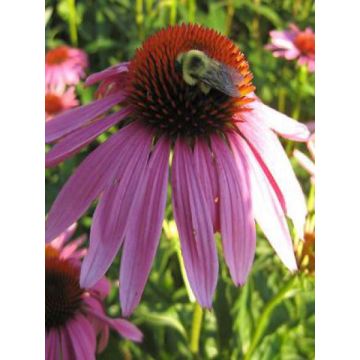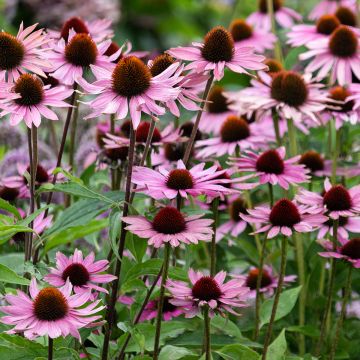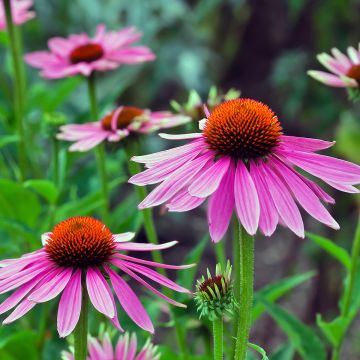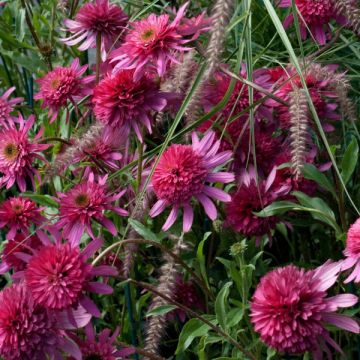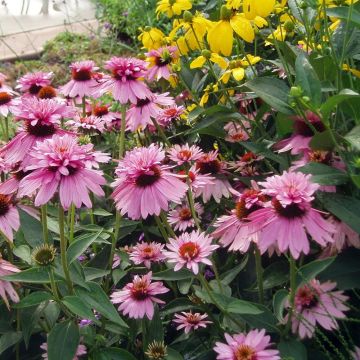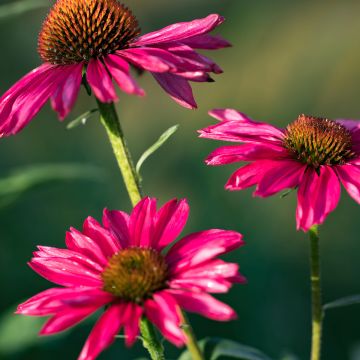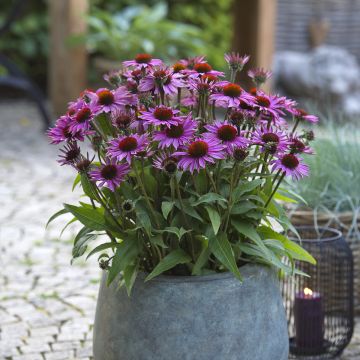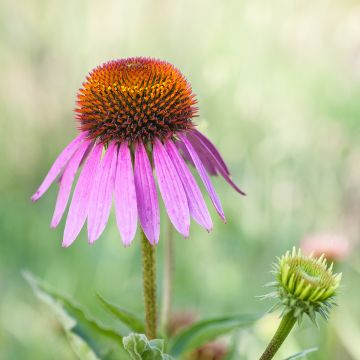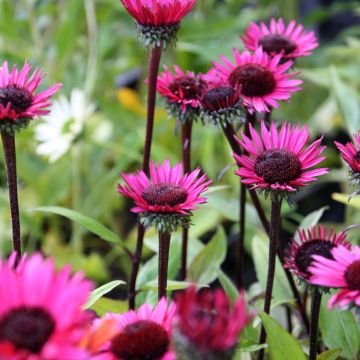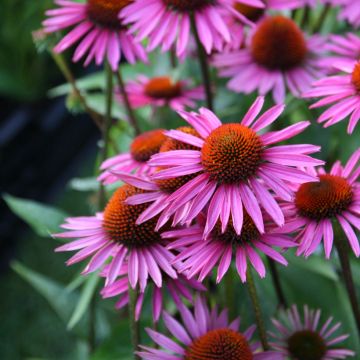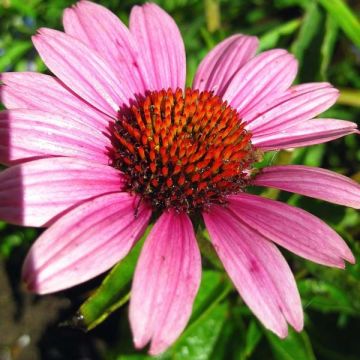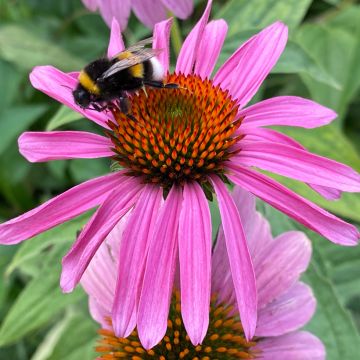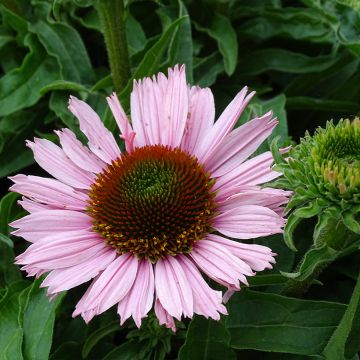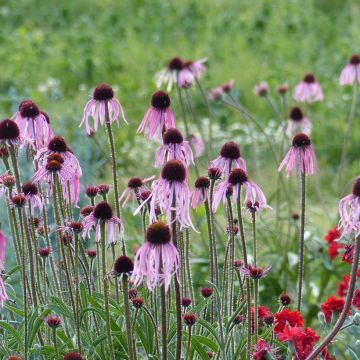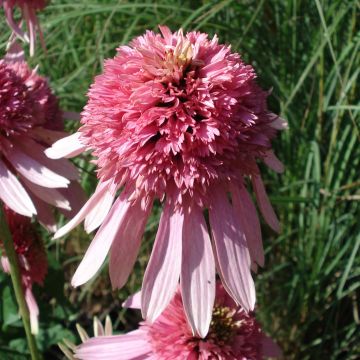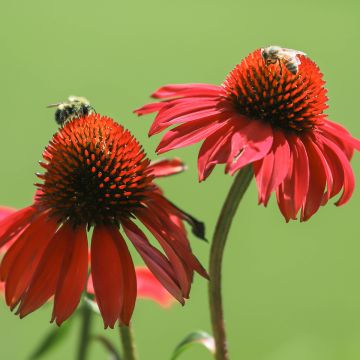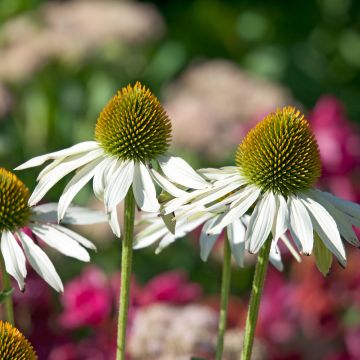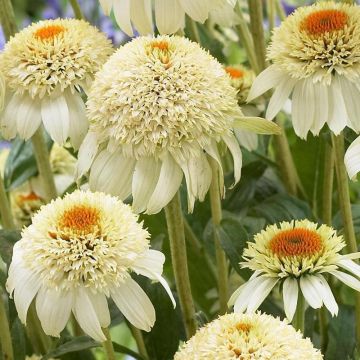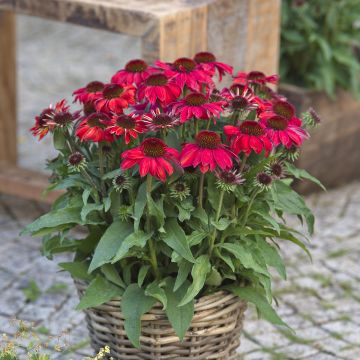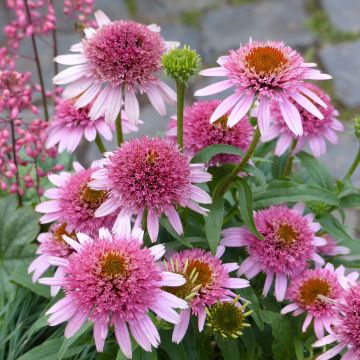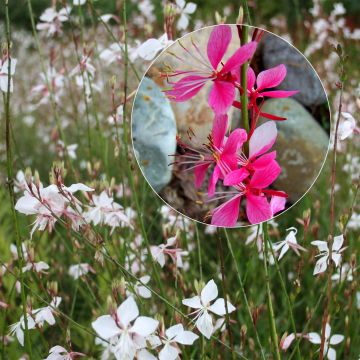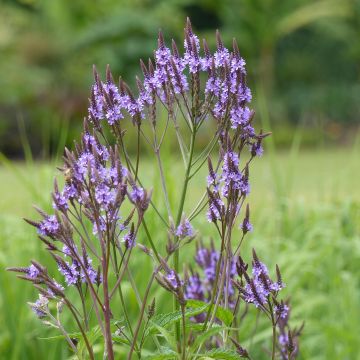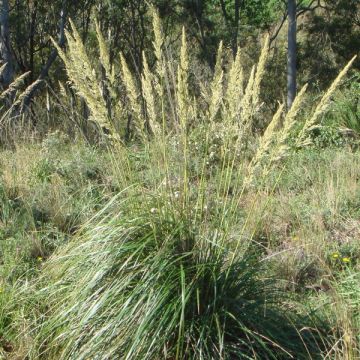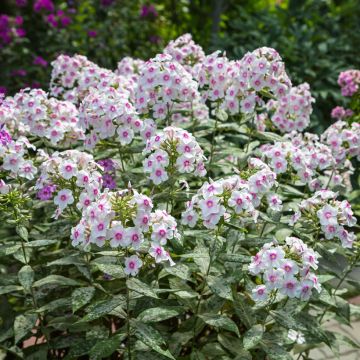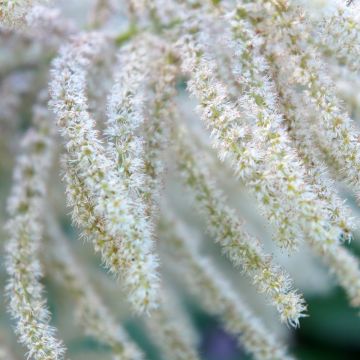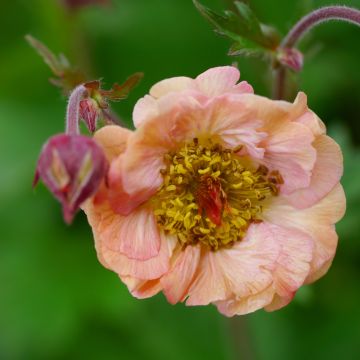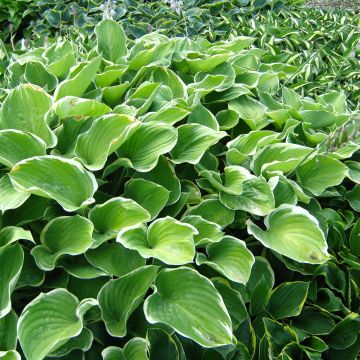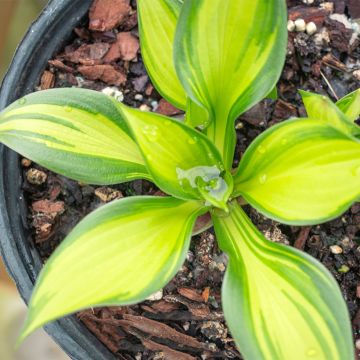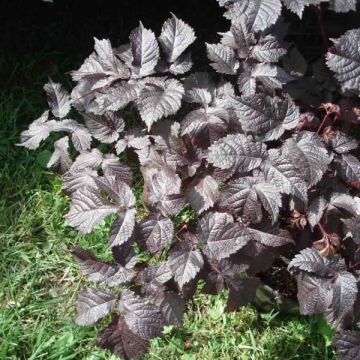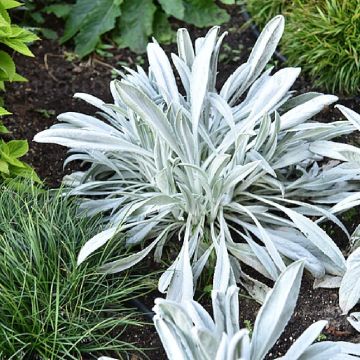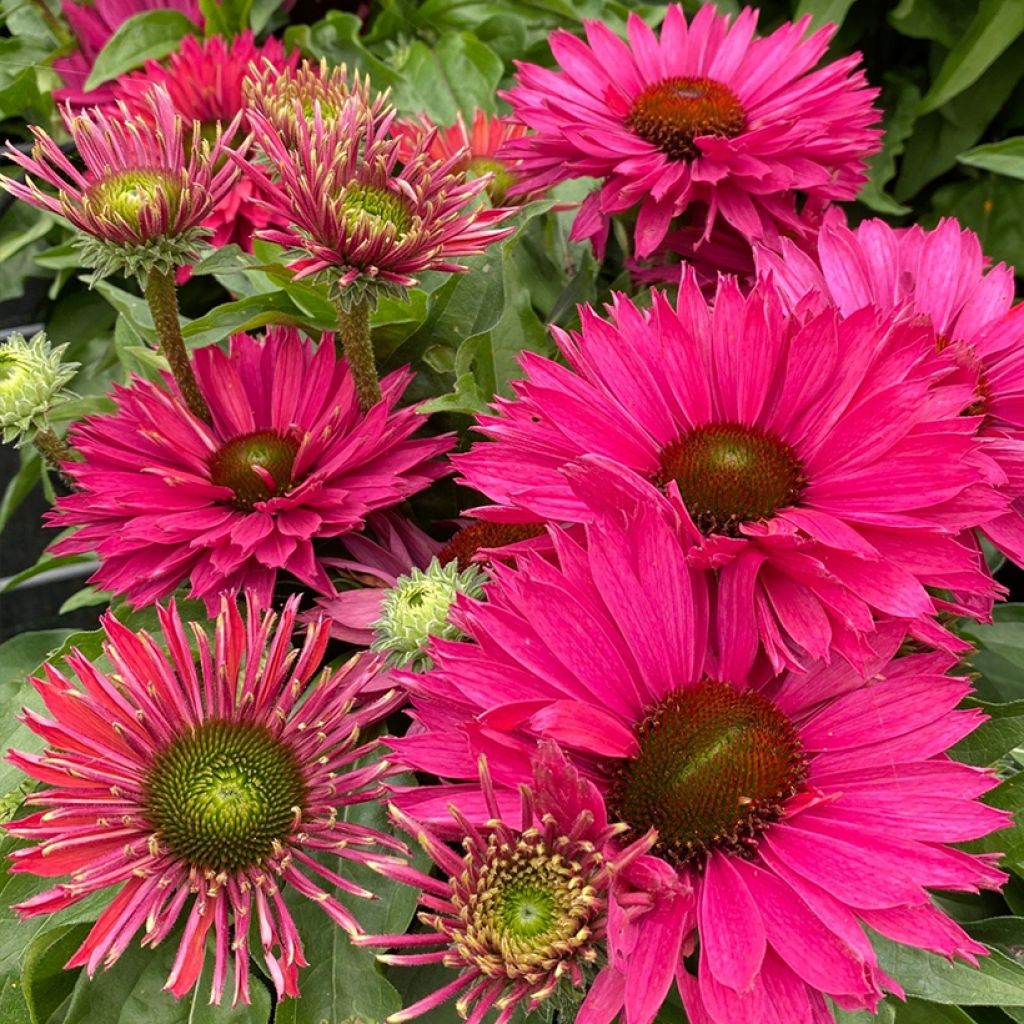

Echinacea SunSeekers Sweet Fuchsia - Purple coneflower
Echinacea SunSeekers Sweet Fuchsia - Purple coneflower
Echinacea purpurea SunSeekers Sweet Fuchsia
Eastern purple coneflower, Purple coneflower
Why not try an alternative variety in stock?
View all →This plant carries a 12 months recovery warranty
More information
We guarantee the quality of our plants for a full growing cycle, and will replace at our expense any plant that fails to recover under normal climatic and planting conditions.
From €5.90 for pickup delivery and €6.90 for home delivery
Express home delivery from €8.90.
Does this plant fit my garden?
Set up your Plantfit profile →
Description
Echinacea SunSeekers Sweet Fuchsia has flowers with an original shape and a very rich colour, which does not fade over time. It has numerous, quite narrow and pointed, vibrant fuchsia pink petals around a green centre that darkens as it matures. It is a compact variety visited by pollinating insects and interesting for its floriferousness and its good performance in flower beds as well as in pots. The flowers bloom for several weeks in summer. It is an easy-to-grow perennial that blends easily with all other plants in the garden or on the terrace. Its flowers are ideal for cutting or drying.
The 'Sweet Fuchsia' Echinacea belongs to the Asteraceae family. This cultivar is part of the remarkable 'SunSeekers' series, which stands out from other echinaceas with their unique flower shapes and colours that do not fade over time. The 'SunSeekers' also have exceptional vigour, with these hybrids producing masses of flowers carried on short stems, above narrow dark green leaves. 'Sweet Fuchsia' forms a dense and sturdy clump, 50 cm (20in) high and 40 cm (16in) wide. The deciduous, lanceolate, opposite green leaves are covered in bristly hairs. The abundant flowering lasts from July to September and is loved by butterflies. The branched, green-red stems are each topped with a solitary head measuring 6 to 8 cm (2 to 3in) in diameter, with a prominent, bristly central green disk surrounded by flat to slightly recurved ligulate, rich purple-pink petals. The fruit is an achene that releases seeds which birds love. This plant firmly and deeply anchors itself in the soil with its highly developed root system.
The 'Sweet Fuchsia' Rudbeckia is easy to grow in ordinary soil. It is very floriferous and ideal for beginner gardeners as well as enthusiasts of endless and colourful blooms. This variety is perfect for cut flowers or drying. Plant it along the edge of a flower bed with flowers of different shapes. Consider sages, carnations, dwarf asters, as well as dwarf daylilies. Add clumps of annuals like Nigellas and small grasses like stipas.
The scent of Echinacea varies depending on the stage of flowering. Initially, when the florets are in an upright crown, the scent is barely noticeable. At full bloom, when the florets droop, it exhales a delicate honey scent which attracts bees, butterflies, and other insects. Once the head is pollinated, the scent takes on a more vanilla note.
A medicinal plant: In homoeopathy, the root of echinacea is used to fight colds and strengthen the immune system. These properties were first used by Native Americans. The name Echinacea comes from the Greek word echinos, meaning "hedgehog-like" or "hairy", and acea, meaning "resembling", referring to the appearance of the flower's centre.
Report an error about the product description
Flowering
Foliage
Plant habit
Botanical data
Echinacea
purpurea
SunSeekers Sweet Fuchsia
Asteraceae
Eastern purple coneflower, Purple coneflower
Cultivar or hybrid
Other Echinacea - Coneflower
Planting and care
Echinacea 'SunSeekers Sweet Fuchsia' sometimes takes time to establish and its growth is rather slow. But once in place, it requires no particular care and is very resistant to pests and diseases. It is best planted in spring, in a sunny location, in a mixture of compost and garden soil. The soil must be deep and loose to accommodate its root system. Mulch the base in May to keep it moist in summer. Remove faded flowers as they appear to prolong flowering. Divide the clump when flowering slows down. It is a rhizome that can become invasive if it likes its surroundings. As the plant ages, it becomes more susceptible to aphid attacks and powdery mildew. Mulch the base in May to keep it moist in summer, as it is susceptible to drought during flowering.
Planting period
Intended location
Care
This item has not been reviewed yet - be the first to leave a review about it.
Summer flowering perennials
Haven't found what you were looking for?
Hardiness is the lowest winter temperature a plant can endure without suffering serious damage or even dying. However, hardiness is affected by location (a sheltered area, such as a patio), protection (winter cover) and soil type (hardiness is improved by well-drained soil).

Photo Sharing Terms & Conditions
In order to encourage gardeners to interact and share their experiences, Promesse de fleurs offers various media enabling content to be uploaded onto its Site - in particular via the ‘Photo sharing’ module.
The User agrees to refrain from:
- Posting any content that is illegal, prejudicial, insulting, racist, inciteful to hatred, revisionist, contrary to public decency, that infringes on privacy or on the privacy rights of third parties, in particular the publicity rights of persons and goods, intellectual property rights, or the right to privacy.
- Submitting content on behalf of a third party;
- Impersonate the identity of a third party and/or publish any personal information about a third party;
In general, the User undertakes to refrain from any unethical behaviour.
All Content (in particular text, comments, files, images, photos, videos, creative works, etc.), which may be subject to property or intellectual property rights, image or other private rights, shall remain the property of the User, subject to the limited rights granted by the terms of the licence granted by Promesse de fleurs as stated below. Users are at liberty to publish or not to publish such Content on the Site, notably via the ‘Photo Sharing’ facility, and accept that this Content shall be made public and freely accessible, notably on the Internet.
Users further acknowledge, undertake to have ,and guarantee that they hold all necessary rights and permissions to publish such material on the Site, in particular with regard to the legislation in force pertaining to any privacy, property, intellectual property, image, or contractual rights, or rights of any other nature. By publishing such Content on the Site, Users acknowledge accepting full liability as publishers of the Content within the meaning of the law, and grant Promesse de fleurs, free of charge, an inclusive, worldwide licence for the said Content for the entire duration of its publication, including all reproduction, representation, up/downloading, displaying, performing, transmission, and storage rights.
Users also grant permission for their name to be linked to the Content and accept that this link may not always be made available.
By engaging in posting material, Users consent to their Content becoming automatically accessible on the Internet, in particular on other sites and/or blogs and/or web pages of the Promesse de fleurs site, including in particular social pages and the Promesse de fleurs catalogue.
Users may secure the removal of entrusted content free of charge by issuing a simple request via our contact form.
The flowering period indicated on our website applies to countries and regions located in USDA zone 8 (France, the United Kingdom, Ireland, the Netherlands, etc.)
It will vary according to where you live:
- In zones 9 to 10 (Italy, Spain, Greece, etc.), flowering will occur about 2 to 4 weeks earlier.
- In zones 6 to 7 (Germany, Poland, Slovenia, and lower mountainous regions), flowering will be delayed by 2 to 3 weeks.
- In zone 5 (Central Europe, Scandinavia), blooming will be delayed by 3 to 5 weeks.
In temperate climates, pruning of spring-flowering shrubs (forsythia, spireas, etc.) should be done just after flowering.
Pruning of summer-flowering shrubs (Indian Lilac, Perovskia, etc.) can be done in winter or spring.
In cold regions as well as with frost-sensitive plants, avoid pruning too early when severe frosts may still occur.
The planting period indicated on our website applies to countries and regions located in USDA zone 8 (France, United Kingdom, Ireland, Netherlands).
It will vary according to where you live:
- In Mediterranean zones (Marseille, Madrid, Milan, etc.), autumn and winter are the best planting periods.
- In continental zones (Strasbourg, Munich, Vienna, etc.), delay planting by 2 to 3 weeks in spring and bring it forward by 2 to 4 weeks in autumn.
- In mountainous regions (the Alps, Pyrenees, Carpathians, etc.), it is best to plant in late spring (May-June) or late summer (August-September).
The harvesting period indicated on our website applies to countries and regions in USDA zone 8 (France, England, Ireland, the Netherlands).
In colder areas (Scandinavia, Poland, Austria...) fruit and vegetable harvests are likely to be delayed by 3-4 weeks.
In warmer areas (Italy, Spain, Greece, etc.), harvesting will probably take place earlier, depending on weather conditions.
The sowing periods indicated on our website apply to countries and regions within USDA Zone 8 (France, UK, Ireland, Netherlands).
In colder areas (Scandinavia, Poland, Austria...), delay any outdoor sowing by 3-4 weeks, or sow under glass.
In warmer climes (Italy, Spain, Greece, etc.), bring outdoor sowing forward by a few weeks.

































